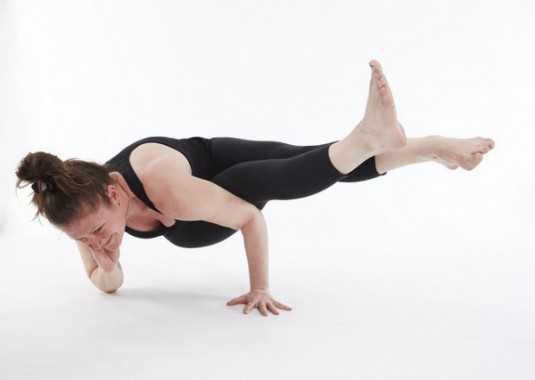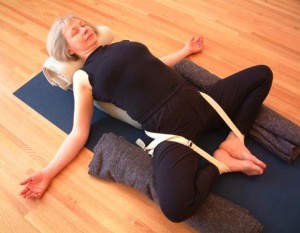I was idly checking Google analytics on Tuesday morning, and on a whim decided to look at the “organic” search terms. Those are the words that people type into the vast waves of the Internet hoping for answers from just about any source.
So what do people type in that casts them up on these shores?
Apart from a number of variations on “five,” “minute,” and “yoga,” they were all over the map, from “headstand preparation” to “back strap shoulders” to “how to step forward from downward dog.”
What caught my eye, down towards the bottom, was the plaintive question: “Why is yoga so hard to do?”
My first response was to smile and think: “Damned if I know, but it sure is hard, isn’t it?”
Later that evening, I used the story to lighten the mood at the 7:30 class. Everyone laughed, and if we can believe the latest research by evolutionary psychologists at Oxford University, their endorphin levels rose, and so did their pain thresholds. That ought to mean that the next pose wasn’t quite so hard to do.
Later I started thinking about the person who landed here by typing in that question, and didn’t find a good answer, or at least a direct one.
So I’d like to fix that.
I’m assuming, by the way, that by “yoga” we can agree we’re discussing a form that includes challenging poses, but doesn’t position itself as a brutal workout. (See Diamond Dallas Page’s “Not Your Momma’s Yoga,” with the 6-minute hold in plank pose.) Those forms are hard to do, but for reasons that have nothing to do with yoga.
I can think of many reasons why yoga is so hard to do, but here are three big ones:
The poses are physically demanding. They just are.
Humankind has been assuming the shapes of yoga poses for thousands of years. But before the 1960s, only a few exceptionally physical people in each generation – gymnasts, acrobats, dancers and yogis – did anything like the yoga we aspire to.
Our grandparents may have been less sedentary than we are, but they didn’t expect to touch their toes, much less put their hands flat on the floor in a straight-leg forward bend.
Doctors didn’t stand on their heads. School teachers didn’t attempt elbow balance. Hairdressers didn’t push up off the floor into a backbend. Accountants didn’t aspire to full lotus – that was a pretzel position to be gaped at in a circus, not something you might be shown how to do on a Thursday night at the community centre.
Yes, practicing poses can lead to flexibility, strength and balance, as well as a quiet mind and a peaceful heart. But the poses have always been difficult. What’s changed is that now we believe everyone can benefit from them.
Yoga is a transformational practice.
To bring intelligence into every cell – another way of saying yoga – means waking up areas of the body that have never been in conscious awareness.
In my experience, cells wake up more like groggy adolescents than like cheerful babies. Sometimes the waking up is unpleasant. Sometimes it hurts. It should, of course, only hurt in the sense of joy pain, but the practice of yoga includes a lot of time spent learning to stay just this side of too much sensation.
That doesn’t mean all yoga is hard to do, or that all transformation requires working your edge. Practicing lying down bound angle pose, for example, is like settling into a cosmic lazy-boy recliner: quiet, open and supported all at the same time.
Still, if you want your body and mind to change by practicing the poses, then the work is going to be hard, much of the time.
Once you have a sustained practice, you’re going to be dealing not just with the difficulty of the poses, but with the reality of physical aging.
After the age of 25, we lose muscle mass at the rate of a half to one per cent a year. And as we age, the process accelerates. It even has a name, sarcopenia, from the Greek, meaning “poverty of flesh.”
At the same time, both age and inactivity make us stiff. The fibres of the fascial network that surrounds and interpenetrates our muscles lose their elasticity. Instead of gliding against one another they become stuck together. If you played a lot of sports as a child and followed that by several years of mostly sitting at a desk, then yes, yoga is hard to do.
And that said, there isn’t a better practice than yoga to counteract the effects of aging. Every practice brings weight bearing to help preserve muscle mass, and stretching, to slow or reverse our increasing tightness.
Yoga doesn’t make me feel like “I never got past age 16,” as 75-year-old yoga teacher Lily Anne Hillis told the San Francisco Chronicle.
I’m stronger and more flexible than I was at 16, but I can tell I’m aging, just by looking in the mirror. Besides, I can no longer go without glasses for distance, as well as for reading. And I have aches from time to time, like everyone else.
But so far, my physical challenges are largely self-imposed.
Usually it’s the continuing battle to push up from the floor in Chatturanga Dandasana, the yoga push up – now that’s hard to do – or to increase my time in headstand.
So hard as it is, I’ll keep practicing.
Because guess what?
Not doing yoga is harder.
Image courtesy of Lululemon, via Flickr.
If this was your kind of post you might also like:
Are some yoga poses lemons?
Morning Practice: If it’s so important, why is it so hard to do?
How to turn your willpower on and stick to your yoga practice






Comments on this entry are closed.
Love the knowledge you share and the curiosity you cultivate! Thank you.
Hi Mary,
You’ve made my day. Best to you.
Beautiful post. Not only do you pose (ha!) a smart question Eve, but you offer clear and informed answers which inspire us to continue. And, as always, so well written. Thanks.
Hey Kris,
Great to hear from you! Nice pun. . . .